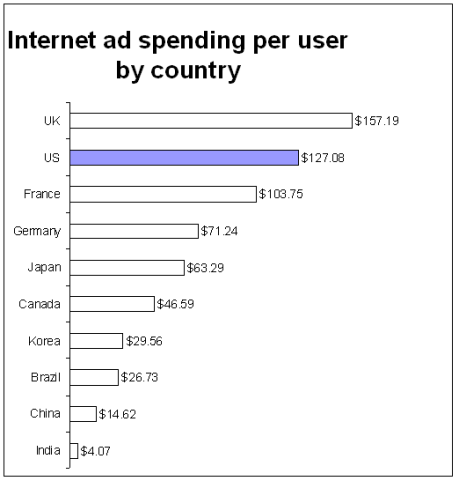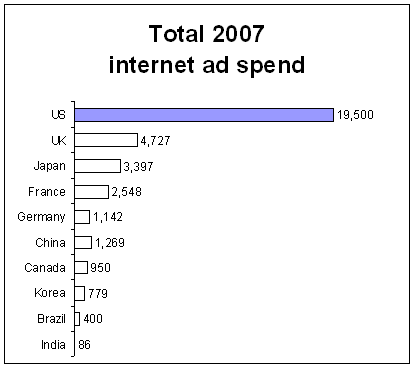USA! USA! USA! We’re number one! May 18, 2007
Posted by jeremyliew in advertising, Consumer internet, international, Internet, start-up, startups, web 2.0.trackback
For many US based startup online media companies, intenational users are largely an afterthought. As I am an Australian, this has always annoyed me. But it is becoming increasingly clear, much as it pains me, that US based startups are right to focus on their home market. When it comes to creating value, non-US users largely don’t matter to them.
I was looking at some research pulled together by Yazid Aksas, a student at Stanford Business School. He pieced together estimates for the 2007 internet advertising market size and the number of internet users in each of the ten countries with the most internet advertising in the world, from various sources*.
The obvious analysis is to look at online ad spending per internet user by country to see where marketers are spending their money to reach internet users
Interestingly, although the US is close to the top of the list, most of the G8 show high ad spend/internet user (with Russia and Italy being the unsurprising exceptions). The UK is even 20% higher than the US. This suggests that there are sizable online media businesses to be built in each of these countries.
Why then are Bebo and Piczo so focused on building their US user bases? Their home in the UK, where they have the most strength, is the market that spends more in online advertising per user than any other in the world!
The answer lies in the absolute size of these online ad markets, and the extremely high economies of scale in the advertising business.
At $19.5bn, the US is four times bigger than the next biggest market, and bigger than all the other markets combined. Internet advertising, like all advertising, is bought on a country by country basis. The fixed costs of setting up a sales office are going to be roughly the same in any country. Given that the upside opportunity is so much bigger in the US, and given that startups need to focus, its no wonder that most US based online media startups focus on their home market. There is more than enough opportunity to build a business here without worrying about the complexities of other geographies.
More mature companies, which can undertake multiple independent initiatives, do start attacking some of the other international markets. Myspace has been very focused on rolling out new geographies in the last twelve months as it can leverage a mature world wide ad sales force through its Fox/News corporate parent.
Google’s advertising revenues match the overall distribution above quite well, with 53% of their revenues in the US and 47% internationally. Their huge scale and self service model allow them to serve all countries without being forced to focus on just one due to the need to focus. Others with a self service model can also take this approach from the beginning
Online media companies that start outside the US tend to be more international in their outlook from the beginning. This may be a reflection of a greater international awareness among European and Asian entrepreneurs, or it may be simply a reflection of smaller domestic markets. Successful startups may outgrow their smaller domestic markets sooner, forcing them to turn to new geographies if they want to maintain their growth. Some of the new generation of European internet startups that have been most aggressively international include Tradedoubler, Skype, Netvibes, Joost, Jahjah, and Wikio (a Lightspeed company) and it is likely no accident that these companies were all founded in countries with a smaller domestic online advertising market.
Can any readers provide some counter examples of US based companies which deliberately targeted an international market before attacking the US? (Friendster‘s South East Asian bias, Orkut‘s Brazilian bias and Hi5‘s Indian bias don’t count since they were not deliberate). if so, please comment.
* Sources were IAB, IAB of Canada, Deuteche Bank, Vunet.com, Internet & Mobile Association of India, eMarketer, Susquehanna Financial Group, Intermeios, GroupM, Comscore


This thoughful post also shows that there is a big growth opportunity for online ad networks in India and China. With India’s economic growth and population size, will online ad spending there remain three orders of magnitude less than the US?
“Can any readers provide some counter examples of US based companies which deliberately targeted an international market before attacking the US?”
Not sure if I would say it was deliberate, but we launched a service called “MyStoreMaps” for eBay sellers. The sevice is pretty straight-forward (you can the map in eBay listings here:
http://tinyurl.com/2b6ze9 (might be expired by the time people read this)
If you’ve ever seen a world-map with little red-stick-pins hanging on an office wall, that’s what we do for eBay sellers showing a world-map of their past customer base.
MyStoreMaps dramatically increases a seller’s credibility and, more importantly, gives a buyer a high-degree of confidence when they are buying from a seller in another country.
While we do not specifically target MyStoreMaps to international sellers, the adoption rate is dramatically higher for international sellers than for USA based sellers. Australians are leading the pack.
Our other service, MyStoreRewards, is adopted about 50/50.
Brian
Fotolog (www.fotolog.com) is big in Southern Europe and Spanish-speaking countries, although it is based in NYC. Om Malik wrote recently that it may be acquired soon. Check out the stats on his blog post:
http://gigaom.com/2007/05/17/is-fotolog-next-in-line-to-be-bought/
I would also include zanox as one of the fastest growing affiliate network based in Germany and already present all over Europe with subsidiaries as well as in APAC and USA. Impressive player to watch in the cpa area.
I think that while many companies target the US initially, they go international as quickly as they can. Give us a break! We have to start somewhere!
[…] in Brazil and India. Friendster and hi5 fall into this bucket as well. As I’ve noted before, the online advertising market in the US is bigger than that in the rest of the world combined. The senior management of these companies know this, and all would love to see more US traffic, but […]
[…] it may prove to be harder to monetize the Hi5 international user base through advertising in the short term, we may well see alternative monetization models emerge. Note slide 48 in Ben […]
Think you have Orkut and Hi5 markets backward – Orkut is big in India and Hi5 is big in South America.
[…] use of Google Trends’ recently updated service for websites in combination with some data on international ad markets shared by Jeremy Liew, Andrew Chen recently came to the conclusion that Facebook has surpassed […]